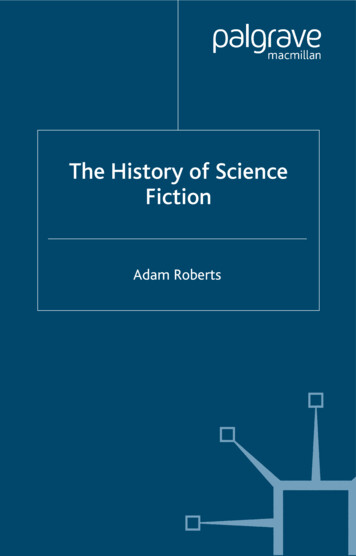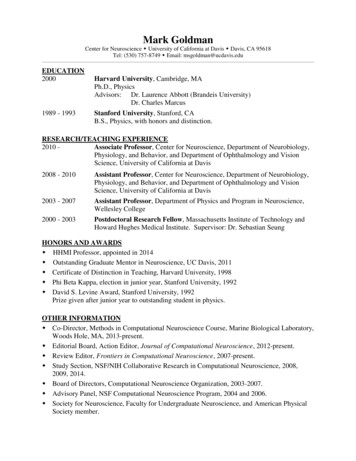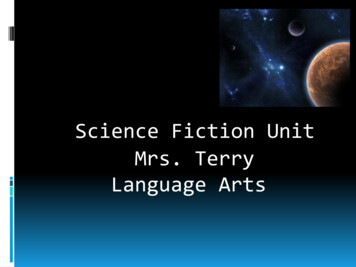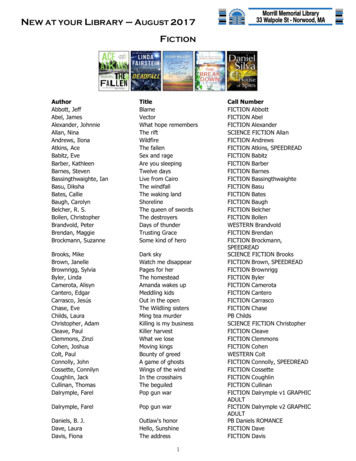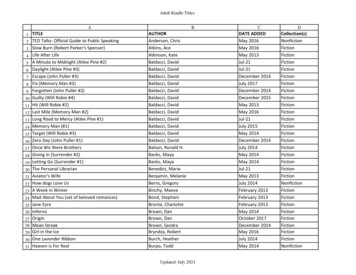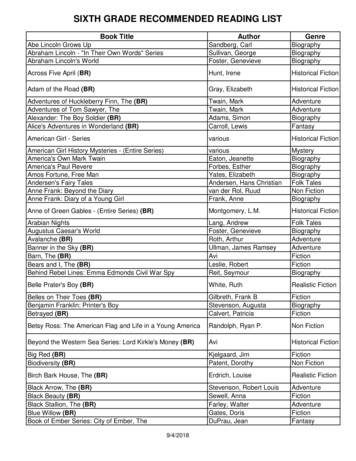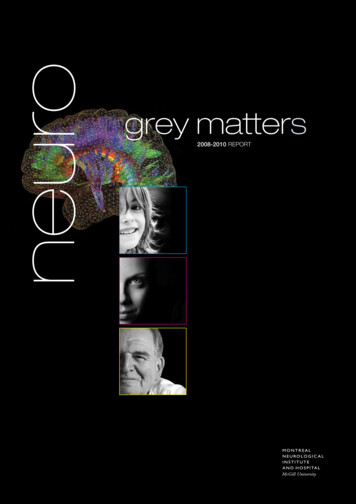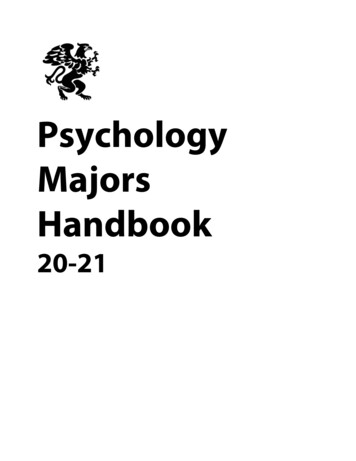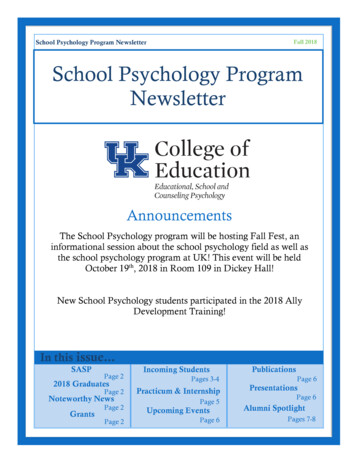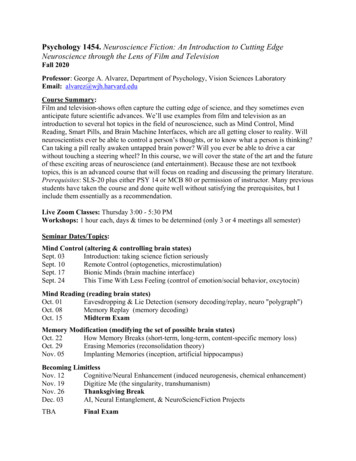
Transcription
Psychology 1454. Neuroscience Fiction: An Introduction to Cutting EdgeNeuroscience through the Lens of Film and TelevisionFall 2020Professor: George A. Alvarez, Department of Psychology, Vision Sciences LaboratoryEmail: alvarez@wjh.harvard.eduCourse Summary:Film and television-shows often capture the cutting edge of science, and they sometimes evenanticipate future scientific advances. We’ll use examples from film and television as anintroduction to several hot topics in the field of neuroscience, such as Mind Control, MindReading, Smart Pills, and Brain Machine Interfaces, which are all getting closer to reality. Willneuroscientists ever be able to control a person’s thoughts, or to know what a person is thinking?Can taking a pill really awaken untapped brain power? Will you ever be able to drive a carwithout touching a steering wheel? In this course, we will cover the state of the art and the futureof these exciting areas of neuroscience (and entertainment). Because these are not textbooktopics, this is an advanced course that will focus on reading and discussing the primary literature.Prerequisites: SLS-20 plus either PSY 14 or MCB 80 or permission of instructor. Many previousstudents have taken the course and done quite well without satisfying the prerequisites, but Iinclude them essentially as a recommendation.Live Zoom Classes: Thursday 3:00 - 5:30 PMWorkshops: 1 hour each, days & times to be determined (only 3 or 4 meetings all semester)Seminar Dates/Topics:Mind Control (altering & controlling brain states)Sept. 03Introduction: taking science fiction seriouslySept. 10Remote Control (optogenetics, microstimulation)Sept. 17Bionic Minds (brain machine interface)Sept. 24This Time With Less Feeling (control of emotion/social behavior, oxcytocin)Mind Reading (reading brain states)Oct. 01Eavesdropping & Lie Detection (sensory decoding/replay, neuro "polygraph")Oct. 08Memory Replay (memory decoding)Oct. 15Midterm ExamMemory Modification (modifying the set of possible brain states)Oct. 22How Memory Breaks (short-term, long-term, content-specific memory loss)Oct. 29Erasing Memories (reconsolidation theory)Nov. 05Implanting Memories (inception, artificial hippocampus)Becoming LimitlessNov. 12Cognitive/Neural Enhancement (induced neurogenesis, chemical enhancement)Nov. 19Digitize Me (the singularity, transhumanism)Nov. 26Thanksgiving BreakDec. 03AI, Neural Entanglement, & NeuroSciencFiction ProjectsTBAFinal Exam
Overview:This goal of this class is for students to learn how neuroscience concepts depicted in movies(e.g., Mind Control, Memory Erasure) might actually be accomplished in the field ofneuroscience, and to present the material in a way that it is accessible to anyone, regardless ofbackground expertise. Each seminar will focus on a particular neuroscience-fiction theme (e.g.,Mind Control), and will follow the same basic structure:- Movies. Every class begins with a brief viewing ( 10-20 min) of at least two movies,which I’ve edited down to convey the core neuroscience-fiction plot points. The goal ofwatching these movies isn’t to critique them, but rather to get you to think creativelyabout the topic.- Brainstorms. We’ll use these movies to launch into Breakout sessions where each groupwill brainstorm a specific neuroscience-fiction topic (e.g., Discuss exactly how a mindcontrol system could be built what are the requirements/issues/challenges?), and thenshare their solutions with the full class.- Primary Reading. Finally, we’ll discuss two primary readings for the week. In any givenweek, each student is assigned to be a “primary reader” on one of the two articles.Primary readers help lead the classroom discussion on each paper, explaining the mainpurpose, methods, findings, raising points of confusion, etc. Because these articles fromthe primary neuroscience literature, they can often be very difficult to read through,particularly if you don’t have a background in neuroscience. BUT learning how to readthese papers and learn about cutting edge research is really the point of the course. This iswhere we spend the bulk of our time, unpacking the terminology and concepts in thesepapers, translating them into plain language, in order to make sure everyoneunderstands the key concepts.Exams:There is a mid-term and a final exam. Given that exams will be taken remotely, in our firstmeeting I will discuss with you my plans for administering them.Workshop:We will have 4-5, 1-hour workshops (times to-be-determined). None of the workshop projectsare graded, although participation is required. The goal of the workshop is to teach you somecutting edge neuroscience methods (without the pressure of being graded), and to give you anopportunity to produce your own work of neuroscience fiction. The workshop is divided into twoparts: (1) During the first half of the semester, we will do a mind reading project, where we willlearn to analyze actual human neural data using cutting edge analysis methods. We will work ingroups, and each group will turn in a power-point lab report when the project is complete. (2)During the second half of the semester, you will create your own work of neuroscience fiction(in groups or on your own), which could be a short-film (funds and equipment available), a shortscreenplay, a graphic novel, or any other piece of neuroscience-fiction you can imagine.Workshop Schedule (Fridays 1 hour, times TBD):WeekWorkshop TopicSep. 24Introduction To Brain Data & Pattern AnalysisOct. 01Introduction To Feature ModelingOct. 08Feature Rating SurveysOct. 15No Workshop (Midterm week)Oct. 22Brain Models Mind ReadingOct. 29NeuroScienceFiction Project Pitch2
Collaboration Policy:No collaboration is allowed during the exams, although you are allowed and encouraged toprepare for the exams in groups. For the workshop, you are encouraged to work in groups.Assigned Reading:See the following pages for a weekly breakdown of the readings. Each week, you will be a“primary reader” for an empirical article. As a primary reader, you will be responsible forleading the discussion and explaining the reading to the rest of the group during the seminar.Although you are the primary reader for only one article per week, you are expected to read andknow the material from all of the assigned readings (2-3 per week).Grading:33% Mid-term Exam33% Final Exam34% Participation (Seminar Workshop)3
Readings should be completedthe exception of Seminar 1).before class (withSeminar 1 (Sept. 03): IntroductionNo reading before the first class.Seminar 2 (Sept. 10): Remote Control (optogenetics)Optional, But Potentially Helpful Background1. Williams, S.C.P. & Deisseroth, K. (2013) Optogenetics. PNAS. October 2013.Primary Readings:1. Anderson, D. J. (2011). Optogenetics, Sex, and Violence in the Brain: Implications forPsychiatry. Biological Psychiatry.2. Liu, X., Ramirez, S., Pang, P. T., Puryear, C. B., Govindarajan, A., Deisseroth, K., et al.(2012). Optogenetic stimulation of a hippocampal engram activates fear memory recall.Nature, 484(7394), 381-385.Seminar 3 (Sept. 17): Bionic MindsOptional, But Potentially Helpful Background1. Thakor, N. V. (2013). Translating the brain-machine interface. Science translationalmedicine, 5(210 210ps17), 1-7.Primary Readings:1. Velliste, M., Perel, S., Spalding, M. C., Whitford, A. S., & Schwartz, A. B. (2008).Cortical control of a prosthetic arm for self-feeding. Neurosurgery, 63(2), N8-N9.2. Raspopovic, S., Capogrosso, M., Petrini, F. M., Bonizzato, M., Rigosa, J., Di Pino, G., .& Micera, S. (2014). Restoring natural sensory feedback in real-time bidirectional handprostheses. Science translational medicine, 6(222 222ra19), 1-12.4
Seminar 4 (Sept. 24): This Time With Less FeelingOptional, But Potentially Helpful Overviews1. (Overview of Kosfeld Reading) Damasio, A. (2005). Brain trust. Nature, 435, 571-572.2. (Overview of Baumgarter Reading) Mauricio, R. M. R. D. (2008). Fool me once, shameon you; fool me twice, shame on oxytocin. Neuron, 58(4), 470-471.Primary Readings:1. Kosfeld, M., Heinrichs, M., Zak, P. J., Fischbacher, U., & Fehr, E. (2005). Oxytocinincreases trust in humans. Nature, 435(7042), 673-676.2. Baumgartner, T., Heinrichs, M., Vonlanthen, A., Fischbacher, U., & Fehr, E. (2008).Oxytocin shapes the neural circuitry of trust and trust adaptation in humans. Neuron,58(4), 639-650.Seminar 5 (Oct. 01): EavesdroppingPrimary Readings:1. Haynes, J. D., & Rees, G. (2006). Decoding mental states from brain activity in humans.Nature Reviews Neuroscience, 7(7), 523-534.2. Nishimoto, S., Vu, A. T., Naselaris, T., Benjamini, Y., Yu, B., & Gallant, J. L. (2011).Reconstructing visual experiences from brain activity evoked by natural movies. CurrentBiology, 21(19), 1641-1646.3. Hasson, U., Nir, Y., Levy, I., Fuhrmann, G., & Malach, R. (2004). Intersubjectsynchronization of cortical activity during natural vision. Science, 303(5664), 1634-1640.4. Greene, J. D., & Paxton, J. M. (2009). Patterns of neural activity associated with honestand dishonest moral decisions. Proceedings of the National Academy of Sciences of theUnited States of America, 106(30), 12506-12511.Seminar 6 (Oct. 08): Memory ReplayPrimary Readings:1. Ji, D., & Wilson, M. A. (2007). Coordinated memory replay in the visual cortex andhippocampus during sleep. Nature Neuroscience, 10(1), 100-107.2. Chadwick, M. J., Hassabis, D., Weiskopf, N., & Maguire, E. A. (2010). DecodingIndividual Episodic Memory Traces in the Human Hippocampus. Current Biology, 20(6),544-547.Midterm Exam (Oct. 15)5
Seminar 7 (Oct. 22): How Memory Works and BreaksOptional, But Potentially Helpful Background1. Tulving, E. (1985). How many memory systems are there? American Psychologist, 40(4),385-398.Primary Readings:2. Verfaellie, M., & O'Connor, M. (2000). A neuropsychological analysis of memory andamnesia. Seminars in Neurology, 20(4), 455-462.Seminar 8 (Oct. 29): Erasing MemoriesOptional, But Potentially Helpful Background1. Karim, K. N. (2003). Memory traces unbound. Trends in Neurosciences, 26(2), 65-72.Primary Readings:1. Schiller, D., Monfils, M. H., Raio, C. M., Johnson, D. C., LeDoux, J. E., & Phelps, E. A.(2009). Preventing the return of fear in humans using reconsolidation updatemechanisms. Nature, 463(7277), 49-53.2. Cao, X., Wang, H., Mei, B., An, S., Yin, L., Wang, L. P., et al. (2008). Inducible andselective erasure of memories in the mouse brain via chemical-genetic manipulation.Neuron, 60(2), 353-366.Seminar 9 (Nov. 05): Memory ImplantsPrimary Readings:1. Berger, T. W., Hampson, R. E., Song, D., Goonawardena, A., Marmarelis, V. Z., &Deadwyler, S. A. (2011). A cortical neural prosthesis for restoring and enhancingmemory. Journal of Neural Engineering, 8(4), 046017-046017.2. Garner, A. R., Rowland, D. C., Hwang, S. Y., Baumgaertel, K., Roth, B. L., Kentros, C.,et al. (2012). Generation of a synthetic memory trace. Science, 335(6075), 1513-1516.3. Shibata, K., Watanabe, T., Sasaki, Y., & Kawato, M. (2011). Perceptual LearningIncepted by Decoded fMRI Neurofeedback Without Stimulus Presentation. Science,334(6061), 1413-1415.6
Seminar 10 (Nov. 12): LimitlessOptional, But Potentially Helpful Background1. Lynch, G., Palmer, L., & Gall, C. M. (2011). The likelihood of cognitive enhancement.Pharmacology, Biochemistry, and Behavior, 99(2011), 116-129.2. A Hypothesis About the Role of Adult Neurogenesis in Hippocampal Function.Physiology (Bethesda), 19(5), 253-261.Primary Readings:1. Farah, M. J., Haimm, C., Sankoorikal, G., & Chatterjee, A. (2009). When we enhancecognition with Adderall, do we sacrifice creativity? A preliminary study.Psychopharmacology, 202(1-3), 541-547.2. Sahay, A., Scobie, K. N., Hill, A. S., O'Carroll, C. M., Kheirbek, M. A., Burghardt, N. S.,et al. (2011). Increasing adult hippocampal neurogenesis is sufficient to improve patternseparation. Nature, 472(7344), 466-470.3. Anguera, J. A., Boccanfuso, J., Rintoul, J. L., Al-Hashimi, O., Faraji, F., Janowich, J., .& Gazzaley, A. (2013). Video game training enhances cognitive control in olderadults. Nature, 501(7465), 97-101.Seminar 11 (Nov. 19): Digitize MePrimary Readings:1. Suchow, J. (2011). NPG's policy on authorship. Nature, 477(7363), 244-244.2. Tucker, P. (2006). The singularity and human destiny. The Futurist, March-April, 38-48.3. Behrens, T. E. J., & Sporns, O. (2012). Human connectomics. Current Opinion inNeurobiology, 22, 144-153.No Class (Nov. 26): Thanksgiving BreakSeminar 12 (Dec. 03): AI, Neural Entanglement, Project PreviewPrimary Readings:TBD7
Neuroscience Fiction: An Introduction to Cutting Edge Neuroscience through the Lens of Film and Television Fall 2020 Professor: George A. Alvarez, Department of Psychology, Vision Sciences Laboratory Email: alvarez@wjh.harvard.edu Course Summary: Film and television-shows often capture the cutting edge of science, and they sometimes even

